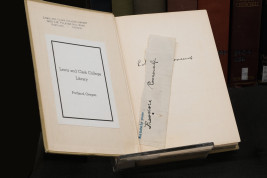The Great War 100 Years Later
A new library exhibition—designed largely by students—examines the impact of World War I on the college, the nation, and the world.
by Angie Jabine
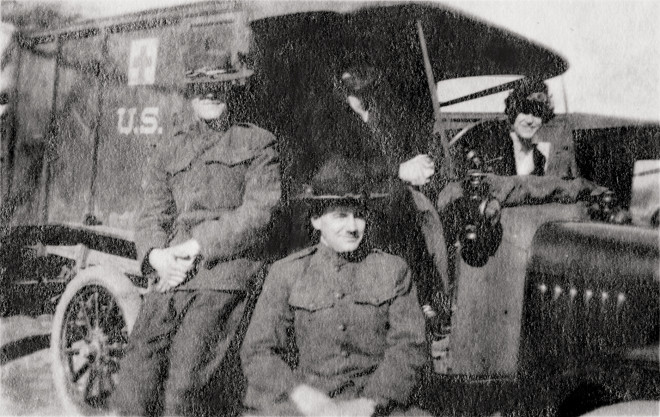
August 1918: It’s nighttime in northeast Italy, not far from the Austrian border. Morgan Odell, a 24-year-old ambulance driver, is wolfing down a long-delayed dinner when enemy shelling begins.
The explosions and bomb craters are safely out of reach—but then come the clouds of poison gas, with their telltale sweetish odor. “We jumped for those ever present masks,” he wrote to his mother. Gas masks were a cumbersome affair: “a pair of pincers on your nose, a hose in your mouth … a strong elastic cutting the top of your head off,” he wrote. “Glad it does not happen very often or I might grow bald-headed.”
June 2015: A history professor and three students sit around a conference table in the Heritage Room of Watzek Library. Silently, each peruses a yellowing stack of letters written to and from that young ambulance driver—who was later to serve an 18-year term as one of Lewis & Clark’s best-loved presidents. The penmanship may be hard to decipher, the pages creased and stained, the descriptions often mundane, but these are pieces of history. When Odell writes of carrying wounded enemies in the dark, when his wife writes of the lethal influenza that was sweeping through Los Angeles, the students interrupt the silence to read out loud.
During summer 2015, David Campion, Pamplin Associate Professor of History, assembled an eager research team to study World War I from varying perspectives.
The team consisted of three students—Sten Eccles-Irwin, Emma Hoch-Schneider, and Nicolas Read— along with assistant archivist Zachariah Selley. Together they created The Great War 100 Years Later: The College, the Country, and the World, a multimedia exhibition now on display in Watzek Library through July 2016. The exhibit explores Odell’s wartime experiences, the war’s long-term social and political consequences, and the war’s impact on the college. With direction from Campion and Selley—and funding from an Andrew W. Mellon Foundation grant to Lewis & Clark —the students undertook the research, writing, design, and installation for both the exhibition and its accompanying catalog.
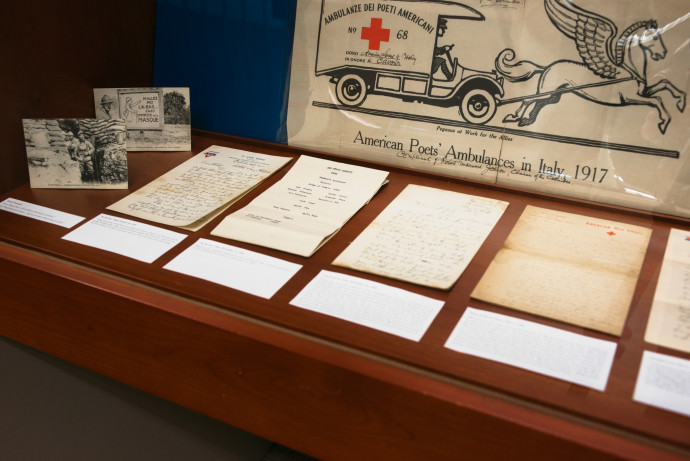
How to Commemorate the Great War?
Professor David Campion is deeply attuned to the history of war. When he earned his graduate degree at the University of Virginia, where his specialty was imperial British India, he was already a Navy veteran. His four-year stint had included three years on a destroyer with deployments to the Mediterranean and Caribbean. For many years, he has been a collector of war medals and other paraphernalia from historic European conflicts, including World War I.
As the hundredth anniversary of the Great War approached, Campion was acutely aware that centenary events were being planned worldwide. In spring 2014, while leading an overseas study program to Australia, he led students on a walking tour of the ANZAC Memorial at Hyde Park in Sydney. Earlier, during a solo trip through New Zealand, he noticed how even the smallest, one-stoplight towns had their own memorials to the casualties of the Great War. “You’d see lists often containing the same surname—brothers, cousins, uncles, nephews,” he recalls. It was a harsh reminder of the losses that so many families sustained a hundred years ago.
Back on campus, Campion sat down with archivist Zach Selley to talk about designing an exhibit in memory of World War I. Selley immediately recalled a stack of French patriotic posters he’d found tucked away in a drawer when he’d arrived at Lewis & Clark three years ago. “As soon as David said, ‘I want to do this,’ I told him, ‘You’ve got to see these posters … I’d love to be able to get them out there and have people enjoy them.’”
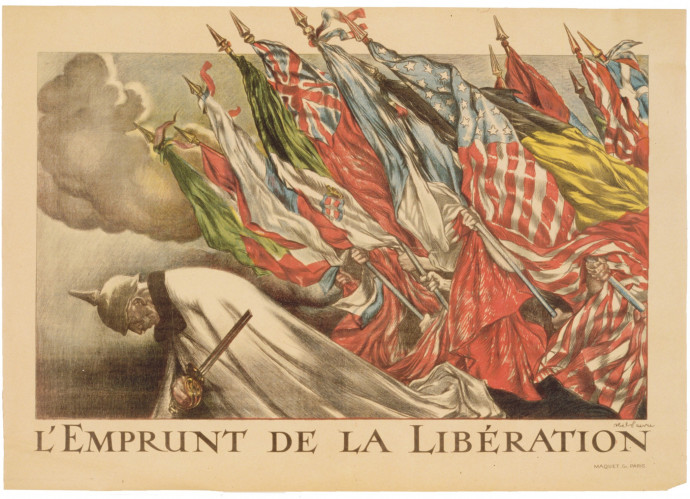
In terms of linking the college to the war, even more important than the posters was the library’s collection of materials about Albany College, the predecessor to Lewis & Clark. Founded in 1867 as a Presbyterian college in Albany, 70 miles south of Portland, the college was thrown into financial turmoil when the Great War swept up the bulk of its male students, who enlisted en masse.
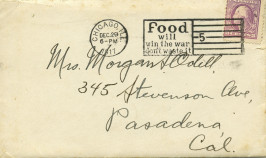
Campion’s team of student researchers came together quickly. Seniors Emma Hoch-Schneider and Sten Eccles-Irwin had both taken Campion’s section of Exploration and Discovery that focused on World War I as part of the required first-year course. They had also both taken History 300: Historical Materials, says Campion, “meaning they knew about editing and using digital resources, so they had the necessary professional background.” But he also wanted the team to be interdisciplinary. Therese Augst, associate professor of German studies, pointed him towards Nicolas Read, then a first-year student, who could translate the French and German documents as needed.
Shortly after the 2014–15 school year ended, Selley brought out the boxes from the college archives, and the assembled team got to work. They focused on several broad themes, including Odell’s experiences in the war, the home front in America, Albany College during the war, the concurrent Irish rebellion, military awards and honors, and the war’s aftermath.
A Multitalented Student Team
A senior who grew up in nearby Beaverton, Oregon, Sten Eccles-Irwin plans to attend medical school and perhaps become a surgeon, but for now he’s a history major. His classes with Professor Campion only heightened a love of history that began for him in high school. That was when he read To End All Wars, Adam Hochschild’s history of the opposition to what was wishfully being called the “war to end all wars.” He also read Hochschild’s King Leopold’s Ghost, which introduced him to British subject Roger Casement, a key figure in the fight for Irish independence. During World War I, Casement secretly visited Germany to recruit Irish prisoners of war to the separatist cause. After the 1916 Easter Rising in Dublin, he was ultimately hanged for treason. The copy of the parliamentary report of inquiry into the Rising displayed in the exhibit bears the signature of the lawyer who defended Casement at his treason trial.
Given his prior interest in Casement, Eccles-Irwin wrote much of the exhibit text on the Easter Rising—with Campion “polishing it up to make it sparkling,” he adds. Eccles-Irwin also devoted many hours to assembling and writing the exhibit’s interactive timeline, an electronic display board that visitors can swipe to view archival images, such as the Italian ship the Giuseppe Verdi, which carried Corporal Odell’s Army unit from their East Coast training camp to action in Italy. But, like his fellow student curators, Eccles-Irwin prefers to emphasize the collaborative nature of the work, not their individual contributions. “We all wrote all of it,” he says simply.
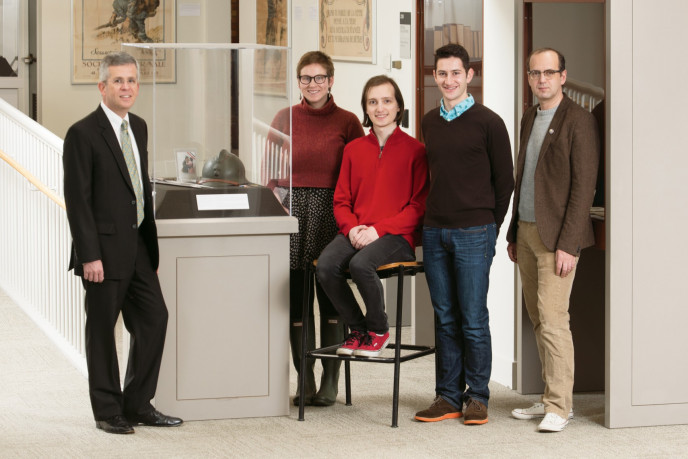
Emma Hoch-Schneider says she got her first exposure to the Great War In high school, studying war poets Wilfred Owen and Siegfried Sassoon, who expressed their generation’s growing disillusionment with technology and the idea of progress. “This exhibit project made me look beyond the dominant narrative of World War I, which is traditionally Germany versus Europe and the U.S.,” she says. Not only did the war encourage women to assert their rights, it sowed the seeds of 20th-century decolonization. “The French and British used their colonial armies to advance their own imperial aims,” she notes, “but those soldiers’ experiences led them to realize that the West was not all-knowing.”
Hoch-Schneider played a key part in developing the exhibit’s graphic look and feel. The banner you see at the entrance, showing a crimson poppy and a line of soldiers silhouetted against the horizon—both icons of the Great War—is largely her work, as are most of the layouts of exhibit text, captions, and imagery. “I now feel very good about my InDesign and Photoshop skills,” she says.
She also wrote the catalog section on the home front. As part of the war effort, women were urged to take a lead role in conserving food and other supplies of use to the military. Ruth Odell’s letters to her husband detailed these efforts, as well as the volunteer work she and Odell’s mother did for the Red Cross. The letters also documented the devastating impact of the “Spanish flu,” which cruelly seemed to single out the most robust young adults. Ruth survived her bout with the flu; at least one close family friend did not.
A senior from Alameda, California, Hoch-Schneider is double majoring in history and biology. She may one day attend medical school, or she may resume her research on women in science—an interest that took her to London in early 2015 for archival research. She praises Campion’s collegial approach to the exhibit project. “We worked with him, not for him,” she notes. “Any input we had, he was really receptive to.”
As the team’s designated translator, Nicolas Read put his linguistic skills to invaluable use in deciphering the rousing sentiments on the French propaganda posters. He also scoured German websites for details about the war medals from Professor Campion’s collection, and wrote the exhibit text about the medals, particularly Germany’s Iron Cross, which became a source of patriotic contention. (As their war losses mounted, the German army began distributing more Iron Crosses to boost morale, but this action only served to devalue the Cross’s significance.)
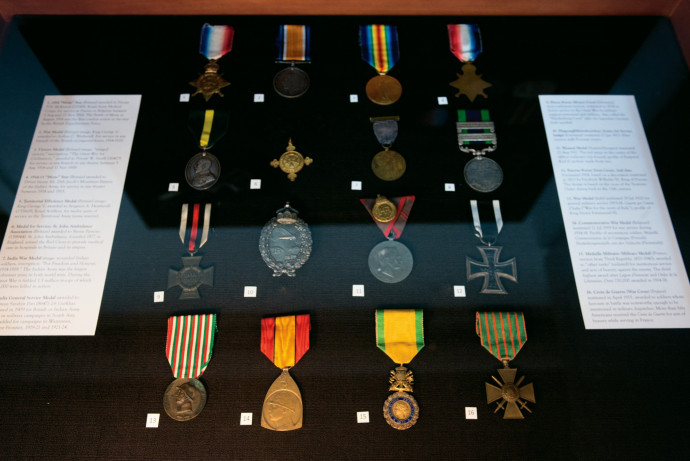
A Surprise in the Stacks
While perusing the Watzek libraries open stacks for World War I materials, Campion stumbled on a third edition of Theodore Roosevelt’s The Great Adventure: Present-Day Studies in American Nationalism. First published in 1918, the book demands Germany’s unconditional surrender and sets the stage for the harsh terms of the Treaty of Versailles in 1919. The book’s flyleaf is signed by Roosevelt’s second wife, Edith, and, slipped inside like a bookmark, is a piece of paper with Theodore Roosevelt’s signature on it. Doug Erickson, the library’s previous director of special collections, has verified the signature; it most likely was trimmed from the bottom of a letter signed by Roosevelt, a common practice among collectors. Campion calls the discovery “quite a surprise. You never know what you’ll discover!” When the exhibit ends in July 2016, the book will be archived in the library’s Heritage Room.
With dual Swiss and U.S. citizenship, Read is pursuing majors in both international affairs and German. He hopes one day to practice international law or diplomacy. He was particularly fascinated by the postwar hyperinflation of German currency, and wrote about it for the exhibit’s “Aftermath” panel. He notes that Lewis & Clark’s archives include a large collection of German letters from the 1920s, the same era of hyperinflation and political turmoil that gave rise to the Nazis and a second world war—a topic he may revisit as a senior.
Read also collaborated with Hoch-Schneider on the design and layout, and he ploughed through the voluminous Odell letters right alongside his teammates. “Odell had so much time during training,” he says with a laugh, “some of his letters were eight to twelve pages long.” Together, the group sorted the wheat from the chaff and determined which letters should be digitalized and transcribed for eventual online access by the public.
A Formative Experience
What struck Campion and his student researchers about the Odell letters was the personal growth they exhibited as the war went on—not just for Morgan but for his wife, Ruth. Raised as a strict Methodist by a Prohibitionist father, Morgan was a straight arrow, and his early letters home during Army training expressed dismay at his comrades’ swearing, smoking, and drinking. He decried in particular their disrespect for the opposite sex—“some women in the future will have to take these men on or what is left of them,” he wrote disgustedly in 1917. But two years later, having served with them under fire, he struck a more thoughtful tone towards these comrades in arms.
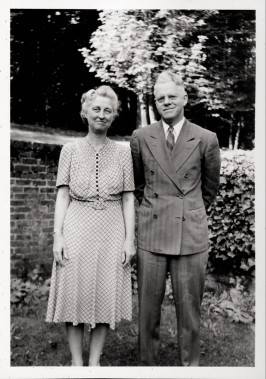
The war may have wreaked untold destruction on a global scale, but Odell’s experiences would serve him well in years to come. In 1942, he became Lewis & Clark’s first president on Palatine Hill, its newly purchased location in Portland. His 18-year term was marked by growing national recognition for the college—and his legacy includes the deep affection and regard of innumerable alumni.
Creating The Great War 100 Years Later proved to be a revelatory experience for all five team members. Selley says the students’ work broadened his views on graphic design for exhibits. Campion says the editing process taught him a new skill. “To present a visual display that is both accessible to a general audience and academically sophisticated proved to be a lot more challenging than I’d expected,” he notes. And the three students relished the chance to revisit and reinterpret this century-old cataclysm, whose impact continues to reverberate in so many ways. As Nicolas Read put it, “It’s incredible that I was able to have such an opportunity.”
Angie Jabine is a Portland-based writer and editor. Her paternal grandfather served with the U.S. Army’s First Gas Regiment in France in 1917–19.
More L&C Magazine Stories
Lewis & Clark Magazine is located in McAfee on the Undergraduate Campus.
MSC: 19
email magazine@lclark.edu
voice 503-768-7970
fax 503-768-7969
The L&C Magazine staff welcomes letters and emails from readers about topics covered in the magazine. Correspondence must include your name and location and may be edited.
Lewis & Clark Magazine
Lewis & Clark
615 S. Palatine Hill Road MSC 19
Portland OR 97219
